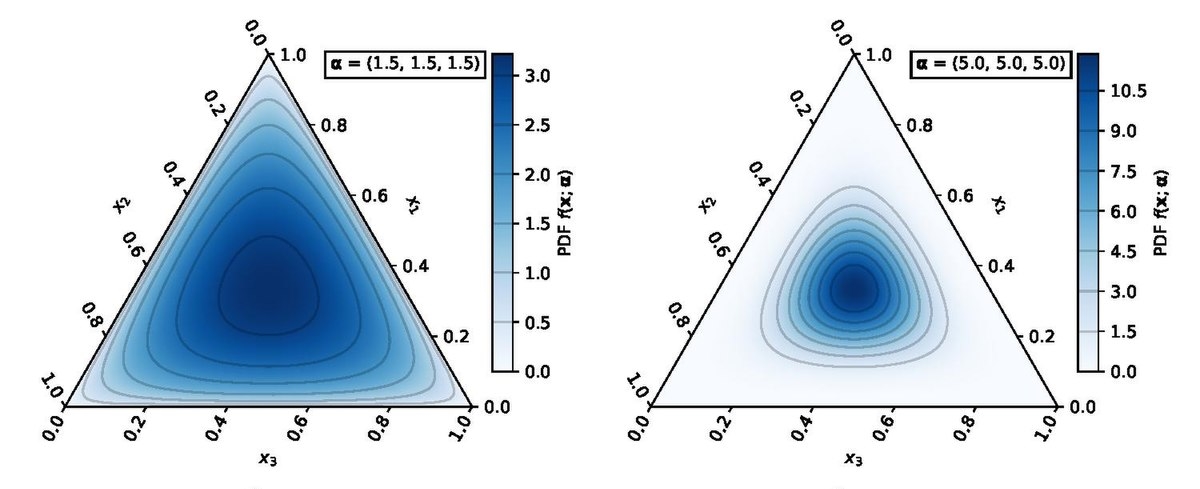KakkoKari (仮) Another (data) science blog. By Alessandro Morita
A vector space structure for probabilities

This post is based on this article
A vector space structure for probabilities
Does it even make sense to discuss about adding two probabilities?
Probabilities definitely look like vectors: they are arrays of numbers. For example, it could make sense that a coin toss would be described by an array with two numbers, something like $(0.5, 0.5)$.
However, it is not obvious how they would inherit any kind of vector space structure (if you need a reminder on vector spaces, Wikipedia is your friend). Here, by vector space, we intuitively mean a space where the operations of
- Adding two vectors, and
- Multiplying a vector by a scalar
are well-defined.
Clearly, element-wise addition doesn’t work for probability vectors: adding the coin toss vector above to itself would yield something like $(0.5+0.5, 0.5+0.5) = (1,1)$, which cannot be a probability since its components do not sum up to 1.
Element-wise multiplication by a scalar suffers from the same issue.
Going to $\mathbb{R}^n$ and back again
Let $\Delta_{K}$ be the $K+1$-dimensional probability simplex,
\[\Delta_K := \left\{ p \in [0,1]^{K+1}: \sum_{k=1}^{K+1} p_k = 1 \right\}\]Define the logit function as the map $\phi: \Delta_K \to \mathbb R^{K}$ such that, if $p_i$ is the $i$-th component of $p$, then
\[\boxed{\phi(p)_i = \log \frac{p_i}{p_{K+1}}}\quad\mbox{(logit function)}\]where the last component $p_{K+1}$ is equal to $1 - \sum_{k=1}^K p_k$.
Similarly, we can compute its inverse as
\[\phi^{-1}(x)_i = \begin{cases} \displaystyle \frac{e^{x_i}}{Z} & \mbox{ if } i \in \{1,\cdots,K\}\\ \displaystyle \frac{1}{Z} & \mbox{ if } i = K+1 \end{cases}\]where the normalization is
\[Z = 1 + \sum_{k=1}^K e^{x_k}\]We define the sum of two points in the simplex as
\[\boxed{|p\rangle + |q\rangle := \phi^{-1}(\phi(p) + \phi(q))}\]and the multiplication by scalar $\cdot$ as
\[\boxed{\alpha |p\rangle := \phi^{-1}(\alpha\, \phi(p))}\]It is easy to show that these two yield
\[\boxed{|p\rangle+|q\rangle = \frac{1}{ \sum_{k=1}^{K+1} p_k q_k} \sum_i p_i q_i |i\rangle}\] \[\boxed{\alpha | p\rangle = \frac{1}{\sum_{k=1}^{K+1} p_k^\alpha} \sum_i p_i^\alpha |i\rangle}\]Some important results:
-
The null vector in $\Delta_K$ is the one relative to the uniform distribution: \(|0\rangle= \sum_{i=1}^{K+1} \frac{1}{K+1} |i\rangle\)
It is easy to show that $ p\rangle + 0\rangle = p\rangle$ for any $p$. -
\[|- p\rangle_i = (-1 |p\rangle)_i = \frac{1/p_i}{\sum_{k=1}^{K+1} 1/p_k}\]The additive inverse, which we call $ - p\rangle$, is exactly $(-1) p\rangle$:
With these operations, $(\Delta_K, +, \cdot)$ is a real vector space!
import numpy as np
import matplotlib.pyplot as plt
from __future__ import annotations
class Prob:
def __init__(self,
coords: np.array):
self.p = np.array(coords)
def __add__(self, q: Prob):
summ = self.p * q.p
summ /= summ.sum()
return Prob(coords=summ)
def __sub__(self, q: Prob):
return self.__add__(q.scalar(-1))
def __mul__(self, a: float):
return self.scalar(a)
def scalar(self, a: float):
coords = (self.p)**a
coords /= coords.sum()
return Prob(coords=coords)
def __repr__(self):
return "("+ ", ".join([str(round(p,4)) for p in self.p]) + ")"
@classmethod
def zero(clf):
return Prob(1/3*np.ones((3)))
z = Prob.zero()
p = Prob([0.3, 0.3, 0.4])
q = Prob([0.2, 0.1, 0.7])
zero = Prob.zero()
zero
# >> (0.3333, 0.3333, 0.3333)
p+zero # zero doesn't do anything
# >> (0.3, 0.3, 0.4)
p_bar = p * (-1) # how does the additive inverse look like?
p_bar
# >> (0.3636, 0.3636, 0.2727)
p+p_bar # should give the zero vector
# >> (0.3333, 0.3333, 0.3333)
def plot_simplex(probs_list, ax=None):
simplex_coords = lambda x, y, z: ((-x+y)/np.sqrt(2), (-x-y+2*z+1)/np.sqrt(6))
coords = np.array([simplex_coords(*p.p) for p in probs_list])
xs, ys = coords[:,0], coords[:,1]
if ax is None:
plt.plot(xs, ys, alpha=0.9)
plt.show()
else:
ax.plot(xs, ys, alpha=0.9)
w.p.sum()
# >> 1.04
fig, ax = plt.subplots()
p_list = [p * a for a in np.arange(-3, 3, 0.01)]
plot_simplex(p_list, ax=ax)
q_list = [q * a for a in np.arange(-3, 3, 0.01)]
plot_simplex(q_list, ax=ax)
w = Prob([0.1, 0.3, 0.6])
w_list = [w * a for a in np.arange(-3,3, 0.01)]
plot_simplex(w_list, ax=ax)
w = Prob([0.18, 0.35, 0.47])
w_list = [w * a for a in np.arange(-3,3, 0.01)]
plot_simplex(w_list, ax=ax)
w = p+q*0.01
w_list = [w * a for a in np.arange(-3,3, 0.01)]
plot_simplex(w_list, ax=ax)
ax.plot([-1/np.sqrt(2), 0], [0, np.sqrt(3/2)], color='gray')
ax.plot([0, 1/np.sqrt(2) ], [np.sqrt(3/2), 0], color='gray')
ax.plot([-1/np.sqrt(2), 1/np.sqrt(2)], [0, 0], color='gray')
[<matplotlib.lines.Line2D at 0x7fb122d9c8b0>]

def plot_simplex(y_true, y_probs, ax=None):
simplex_coords = lambda x, y, z: ((-x+y)/np.sqrt(2), (-x-y+2*z+1)/np.sqrt(6))
xs, ys = simplex_coords(y_probs[:,0], y_probs[:,1], y_probs[:,2])
if ax is None:
plt.plot(xs, ys, c=y_true, alpha=0.5, marker='.')
plt.show()
else:
ax.plot(xs, ys, c=y_true, alpha=0.5, marker='.')
from sklearn.datasets import make_classification
from sklearn.model_selection import train_test_split
from sklearn.metrics import roc_auc_score
from sklearn.linear_model import LogisticRegression
from sklearn.ensemble import RandomForestClassifier
X, y = make_classification(n_classes=3,
n_samples=3000,
random_state=2,
n_features=10,
n_informative=10,
n_redundant=0,
n_repeated=0)
X_train, X_test, y_train, y_test = train_test_split(X, y, random_state=23)
model = RandomForestClassifier(random_state=3)
model.fit(X_train, y_train)
y_probs_rf = model.predict_proba(X_test)
y_probs_train_rf = model.predict_proba(X_train)
def logit2(p):
p1, p2, p3 = p[0], p[1], p[2]
return np.array([np.log(p1/p3), np.log(p2/p3)])
def inv_logit2(x):
xx = np.append(x,0)
Z = 1 + np.exp(x).sum()
return 1/Z * np.exp(xx)
p = np.array([0.3, 0.1, 0.6])
assert np.all(inv_logit2(logit2(p)) == p)
def rot(theta):
c, s = np.cos(theta), np.sin(theta)
return np.array([[c, s],[-s,c]])
fig, ax = plt.subplots()
for p in [
np.array([0.9, 0.05, 0.05]),
np.array([0.99, 0.005, 0.005]),
np.array([0.33, 0.33, 0.34]),
np.array([0.6, 0.2, 0.2]),
# np.array([0.2, 0.2, 0.6]),
# np.array([0.2, 0.6, 0.2]),
]:
rotated_x = [rot(theta) @ logit2(p) for theta in np.arange(0, 6.28, 0.01)]
rotate_p = [inv_logit2(xx) for xx in rotated_x]
plot_simplex(None, np.array(rotate_p), ax)
ax.plot([-1/np.sqrt(2), 0], [0, np.sqrt(3/2)], color='gray')
ax.plot([0, 1/np.sqrt(2) ], [np.sqrt(3/2), 0], color='gray')
ax.plot([-1/np.sqrt(2), 1/np.sqrt(2)], [0, 0], color='gray')